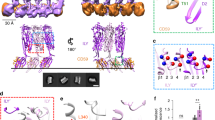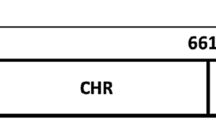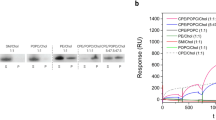Abstract
Perfringolysin O (PFO), a cytolytic toxin secreted by pathogenic Clostridium perfringens, forms large pores in cholesterol-containing membranes. Domain 4 (D4) of the protein interacts first with the membrane and is responsible for cholesterol recognition. By using several independent fluorescence techniques, we have determined the topography of D4 in the membrane-inserted oligomeric form of the toxin. Only the short hydrophobic loops at the tip of the D4 β-sandwich are exposed to the bilayer interior, whereas the remainder of D4 projects from the membrane surface and is surrounded by water, making little or no contact with adjacent protein monomers in the oligomer. Thus, a limited interaction of D4 with the bilayer core seems to be sufficient to accomplish cholesterol recognition and initial binding of PFO to the membrane. Furthermore, D4 serves as the fulcrum around which extensive structural changes occur during the formation and insertion of the large transmembrane β-barrel into the bilayer.
This is a preview of subscription content, access via your institution
Access options
Subscribe to this journal
Receive 12 print issues and online access
$189.00 per year
only $15.75 per issue
Buy this article
- Purchase on Springer Link
- Instant access to full article PDF
Prices may be subject to local taxes which are calculated during checkout



Similar content being viewed by others
References
Alouf, J.E. & Freer, J.H. The Comprehensive Sourcebook of Bacterial Protein Toxins (Academic Press, London; 1999).
Olofsson, A., Hebert, H. & Thelestam, M. FEBS Lett. 319, 125–127 (1993).
Tweten, R.K., Parker, M.W. & Johnson, A.E. Curr. Top. Microbiol. Immunol. 257, 15–33 (2001).
Heuck, A.P., Tweten, R.K. & Johnson, A.E. Biochemistry 40, 9065–9073 (2001).
Iwamoto, M., Ohno-Iwashita, Y. & Ando, S. Eur. J. Biochem. 194, 25–31 (1990).
Tweten, R.K., Harris, R.W. & Sims, P.J. J. Biol. Chem. 266, 12449–12454 (1991).
Nakamura, M., Sekino, N., Iwamoto, M. & Ohno-Iwashita, Y. Biochemistry 34, 6513–6520 (1995).
Nakamura, M., Sekino-Suzuki, N., Mitsui, K.-I. & Ohno-Iwashita, Y. J. Biochemistry 123, 1145–1155 (1998).
Sekino-Suzuki, N., Nakamura, M., Mitsui, K.-I. & Ohno-Iwashita, Y. Eur. J. Biochem. 241, 941–947 (1996).
Rossjohn, J., Feil, S.C., Mckinstry, W.J., Tweten, R.K. & Parker, M.W. Cell 89, 685–692 (1997).
Shepard, L.A. et al. Biochemistry 37, 14563–14574 (1998).
Shatursky, O. et al. Cell 99, 293–299 (1999).
Heuck, A.P., Hotze, E.M., Tweten, R.K. & Johnson, A.E. Mol. Cell 6, 1233–1242 (2000).
Hotze, E.M. et al. J. Biol. Chem. 277, 11597–11605 (2002).
Heuck, A.P. & Johnson, A.E. Cell Biochem. Biophys. 36, 89–102 (2002).
Crowley, K.S., Liao, S., Worrell, V.E., Reinhart, G.D. & Johnson, A.E. Cell 78, 461–471 (1994).
Hamman, B.D., Hendershot, L.M. & Johnson, A.E. Cell 92, 747–758 (1998).
Shepard, L.A., Shatursky, O., Johnson, A.E. & Tweten, R.K. Biochemistry 39, 10284–10293 (2000).
Hotze, E.M. et al. J. Biol. Chem. 276, 8261–8268 (2001).
Gilbert, R.J.C. et al. J. Mol. Biol. 284, 1223–1237 (1998).
Weis, S. & Palmer, M. Biochim. Biophs. Acta 1510, 292–299 (2001).
Kraulis, P.J. J. Appl. Crystollagr. 26, 283–291 (1993).
Meritt, E.A. & Bacon, D.J. Methods Enzymol. 277, 505–524 (1997).
Christopher, J.A. SPOCK: the structural properties observation and calculation kit. (Texas A&M University, College Station; 1998).
Acknowledgements
This work was supported by NIH and by the Robert A. Welch Foundation.
Author information
Authors and Affiliations
Corresponding author
Ethics declarations
Competing interests
The authors declare no competing financial interests.
Rights and permissions
About this article
Cite this article
Ramachandran, R., Heuck, A., Tweten, R. et al. Structural insights into the membrane-anchoring mechanism of a cholesterol-dependent cytolysin. Nat Struct Mol Biol 9, 823–827 (2002). https://doi.org/10.1038/nsb855
Received:
Accepted:
Published:
Issue Date:
DOI: https://doi.org/10.1038/nsb855
This article is cited by
-
Story of Pore-Forming Proteins from Deadly Disease-Causing Agents to Modern Applications with Evolutionary Significance
Molecular Biotechnology (2023)
-
Cholesterol Enriched Archaeosomes as a Molecular System for Studying Interactions of Cholesterol-Dependent Cytolysins with Membranes
The Journal of Membrane Biology (2018)
-
Lipidome and Transcriptome Profiling of Pneumolysin Intoxication Identifies Networks Involved in Statin-Conferred Protection of Airway Epithelial Cells
Scientific Reports (2015)
-
Vertical collapse of a cytolysin prepore moves its transmembrane β-hairpins to the membrane
The EMBO Journal (2004)



